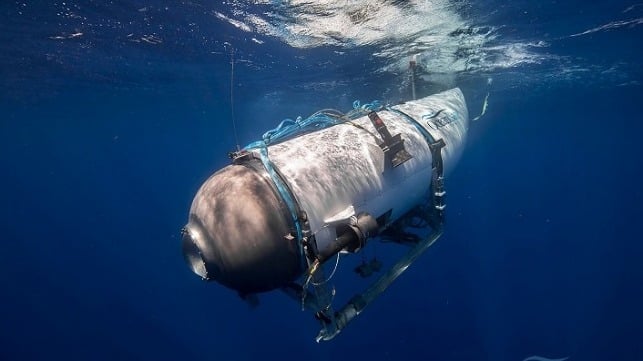NTSB: Poor Engineering, Loose Regulations Led to Sub Titan's Loss

The NTSB has issued a report on the sinking of the "experimental" submersible Titan off Newfoundland in 2023, which killed all five aboard, including company founder and CEO Stockton Rush The report largely concurs with the previously-issued findings of the U.S. Coast Guard: the sub's carbon fiber hull was likely under-engineered and below required strength for the application; OceanGate ignored warning signs of damage from previous dives; and the company's procedures and testing in the run-up to the casualty were not sufficient to mitigate risk.
Deep sea subs are technically demanding to build and operate, generally putting them in the category of nation-state capabilities. Startup operator OceanGate hoped to make ultra-deep dives accessible to a larger audience by keeping costs down. With a novel carbon-fiber hull design that was less expensive to produce, it hoped to market "scientific" dive expeditions to high-net-worth individuals at prices in the range of five to six figures per person. In keeping with the firm's cost-reduction focus, CEO Richard Stockton Rush III opted not to pursue classification or a Coast Guard Certificate of Inspection (COI) for the sub design, his former employees told the Coast Guard - despite plans to operate at 4,000 meters of depth, where the ocean exerts extreme pressure and there is little margin for error.
The sub entered operation in 2021, and OceanGate moved forward with a business plan to offer surveys of the wreck of the Titanic at a cost of $125,000-250,000 per individual. The first two seasons were plagued by technical issues, including a "loud bang" incident in 2022 that was accompanied by aberrant hull strain gauge readings - a sign of possible hull delamination, according to NTSB.
On June 18, 2023, the sub dove at the Titanic wreck site with Rush at the controls and four other personnel on board. At 3,300 meters of depth, it disappeared. After a multiday search, its wreckage was found on the bottom and retrieved. The Coast Guard's engineering experts concluded that it imploded violently under pressure, and the probable failure point was either an adhesive joint at the forward dome or the carbon fiber hull near the forward end.
The NTSB added that its investigators found two long voids in between layers of hull material, formed during construction, which could have contributed to delaminations. Overwinter damage from outside storage and exposure to freezing conditions from 2022-23 could have worsened the problem. This would be consistent with the evidence from the wreckage, according to the agency. "The layers of the cylinder had peeled apart, producing extensive peel separation fractures of the hull, which is typical of a local buckling failure," NTSB concluded. "Delaminations are a known cause of local buckling failures."
The flaws could have been caught internally, both agencies concluded. The Coast Guard's post-casualty investigation found that the OceanGate's safety culture and operational practices were “critically flawed,” with glaring dispraises between written safety protocols and actual practices. The USCG's report asserts that Rush made efforts to misrepresent Titan as indestructible, and used the threat of firings to silence employees who raised safety concerns. In its newly-released analysis, NTSB added that the company failed to carry out a proper life-cycle analysis to figure out how long the hull would last, and did not fully understand how the flaws in its carbon-fiber winding process could negatively affect durability.
NTSB also found that the Coast Guard passenger-vessel regulatory regime was too easy for OceanGate to work around by designating its sub as a "research" vessel, despite the outsize payments that the company collected from the "mission specialists" who boarded it for trips to the bottom. If the Coast Guard had treated Titan as a for-hire passenger vessel, reflecting the paid-for nature of the trips, it would have come under more scrutiny and inspection.
"The existing regulations and voluntary guidance, as currently written, enabled OceanGate’s operation of the Titan in an unsafe manner," the board wrote. "The NTSB concludes that voluntary guidance and current US small passenger vessel regulations are not sufficiently tailored to current [Pressure Vessel for Human Occupancy, or PVHO] operations to ensure the safety of PVHOs in accordance with established technical and classification society standards."
